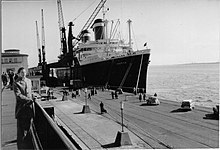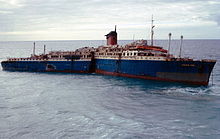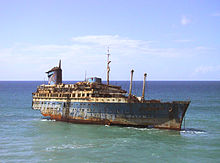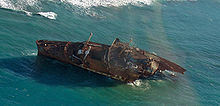America (ship, 1940)
|
||||||||||||||||
|
||||||||||||||||
|
||||||||||||||||
|
||||||||||||||||
The steam turbine ship America was a passenger ship that was built for the United States Lines . It was intended for traffic on the North Atlantic route and was used, among other things, as a military transporter and cruise ship. In 1994, the America tore herself from the lines of her tugboat during a storm off the Canary Islands and stranded in a bay on the west coast of Fuerteventura . The bow section still preserved was a tourist attraction for a long time, but has been almost completely under the water surface since March 2007. It is 28 ° 20 '45 " N , 14 ° 10' 49.8" W .
Later names for this ship were: USS Westpoint (AP-23), Australis , Italis , Noga , Alferdoss and American Star .
construction
The steam turbine ship America was designed by William Francis Gibbs on behalf of the United States Maritime Commission (MARCOM). On August 22, 1938, the ship was laid down in the Newport News Shipbuilding and Dry Dock Company shipyard in Virginia. It was the first ship to be built as part of the 1936 rebuilding program of the Merchant Marine Act. A good year later, on August 31, 1939, it was launched . The ship was christened by Eleanor Roosevelt , wife of Franklin D. Roosevelt . World War II began one day after the launch . In the same shipyard, the United States was built after America , which became famous for winning the Blue Ribbon .
During the first test drives, a problem with the construction became apparent: the rear chimney, which was the only one used for the smoke outlet, could not keep the exhaust smoke away from the decks. Therefore, it and the front "dummy", which housed an emergency generator, were raised by five meters. This also improved the profile of the ship. The America was handed over to the shipping company on June 2, 1940.
Wartime
The ship could not be used for the North Atlantic service after the beginning of the Second World War, contrary to what was planned. Instead, it was used as a cruise ship in American waters and the West Indies in the Caribbean. In order not to be confused with a ship of a warring nation in the neutral waters, the sides were painted with their name and a large American flag. The first cruise was on August 10, 1940 from New York to the West Indies.
After the USA entered the war, the ship was taken over by the US Navy in 1942 and converted into a troop transport. For this it was named USS Westpoint . The conversion took just eleven days. The Westpoint could carry 7,678 passengers. In addition, 4 single 5 inch dual-purpose guns , 4 3 inch / 50 naval guns and 8 .50-cal. Machine guns installed. From 1941 to 1946 the ship carried more than 350,000 people as a troop transport and drove a distance that corresponds to the length of about 15 circumnavigations of the earth. It survived the war without major damage.
The time in the liner service

United States Lines (1946–1964)
On July 22, 1946, the ship was released from service and returned to the United States Lines . In their shipyard, the now renamed America was overhauled, which cost around 6.9 million dollars. From now on she had a tonnage of 26,314 GRT and a total of 1,689 people. From November 14th she operated the route New York - Le Havre and thus took over the transatlantic service originally intended for her. She also called at the ports of Southampton , Cobh and, from October 25, 1951, Bremerhaven . When her successor, the similarly built United States , set out on her record run on July 3, 1952 and won the Blue Ribbon , America fell a little in the shadow of her half-sister. From 1960 she had to serve as a cruise ship again due to the success of the transatlantic flights. In September 1963, the America had to temporarily suspend its voyages because of a dispute with union officials over sanitation on the ship. She was moored in Hoboken until February 1964, but then resumed service.
Okeania SA (1964-1978)
As the business situation of the United States Lines had worsened, America was sold in November 1964 for $ 4,250,000 to Okeania SA , a subsidiary of the Chandris group. The America was renamed Australis and converted into a single-class ship for 2,258 passengers with 26,485 GRT in Piraeus . It was also painted white and had blue chimneys with a capital Χ (Greek letter Chi ) on the sides . On August 20, 1965, she began her first voyage under the new shipping company from Piraeus to Sydney . From October 16 of the same year, she drove a route around the world, from Southampton through the Mediterranean to Australia and New Zealand, on to Mexico, through the Panama Canal and the Caribbean until she arrived back in Southampton. The susceptibility of the white painting to rust and dirt prompted the shipowner to have the hull painted gray / red towards the end of 1967. In this context, the rear mast was also removed. On October 22, 1970, a fire broke out in the ship's kitchen, which could only be extinguished after nine hours. The Australis was so badly damaged that it had to be repaired on the Fiji Islands for several days before the voyage could continue. From 1969 to 1976 the ship sailed under the Panamanian flag. During this time, she carried more passengers than any other liner. However, with the boom in air travel, the ship lost its importance and began to run into debt again. On November 18, 1977, she made the last trip on this route. She was then withdrawn and moored in Timaru , New Zealand.
The era as a cruise ship
Venture Cruise Lines (1978)
In early 1978 the ship was sold to the American Cruise Line , which then changed the company name to Venture Cruise Lines . The Australis arrived in New York on May 19 and was renamed back to America . It also got an overhaul and a blue paint job. The displacement was now 26,353 GRT. Venture Cruise Lines intended to use the ship for short cruises. Two trips took place, the first of which on June 30, 1978 to Martha's Vineyard . However, the ship was then taken out of service again. The America was in good condition from the outside, but the interior was catastrophic. For example, parts of the ship had not yet been completed and the sanitary facilities were not yet functional. In addition, the mattresses were old and bugs abound. Finally, the ship was overbooked, which put customers off even more. The financial damage that the shipping company suffered from this incident forced them to hang up the America in New York . Shortly afterwards, on July 20, 1978, the shipping company went bankrupt.
Okeania SA (1978–1980)
On August 28, 1978, an American district court auctioned America for one million dollars back to the Chandris Group, which registered it as Italis for Okeania SA . The ship received a major overhaul in Eleusis , Greece, during which, among other things, the front chimney was removed. The reason for this measure was the already well advanced corrosion . In addition, the ship received a new, more modern-looking profile, which the owners hoped for higher income. The outdated machines also required an urgent overhaul or renewal, which was never carried out. At that time, the Italis was one of the last steam-powered ships of this size.
From the middle of 1979 the Italis started with Mediterranean cruises . Mostly she transported Latin Americans who came from Barcelona . On September 12, 1979, the now 41-year-old ship was launched in Eleusis.
Laying time and end
Inter Commerce Corporation (1980-1984)
In May 1980 the ship was sold to the Inter Commerce Corporation , a subsidiary of the Cie Noga d'Importation et d'Exportation (Panama), behind which there were Swiss interested parties. The ship, renamed Noga , was intended for use as a floating hotel. However, the plan was never realized.
Silver Moon Ferries (1984-1992)
The ship lay in Eleusis for many years. In September 1984 it was sold to Silver Moon Ferries . The Noga was renamed Alferdoss (Arabic for paradise) and was firmly anchored in Eleusis for more years. They waited for the price of scrap to go up so that scrapping would be profitable. At the end of the 1980s, the Alferdoss was sold to a scrap dealer. He made an offer of two million dollars for the ship. After he had paid a million dollars, the lifeboats and their davits began to be cleared from the deck with forklifts . The scrap dealer, however, withdrew from his offer, and so the Silver Moon Ferries remained the million dollars and a ship without lifeboats.
In 1988 a bilge pipe broke overnight , allowing water to enter the hull. The next day, the starboard anchor was raised, the port anchor was cut and the ship was put aground to avoid sinking. The ship was later pumped dry, repaired and brought back to its berth.
Chaophraya Developement Transport Company (1992-1994)
In 1992 the Alferdoss was sold for two million dollars to the Chaophraya Developement Transport Company , which renamed the ship the American Star . The liner was drained and it was found that the hull was in good condition, given the circumstances. Now the ocean liner should be converted into a floating hotel off the island of Phuket in Thailand . To do this, the propellers were removed to reduce drag in the water and the chimney was repainted.
The Ukrainian tug Neftegaz 67 was supposed to pull the American Star from Eleusis to Thailand, but returned to the port one day after the start of the voyage, as a strong storm prevented the voyage. On December 31, 1993, the American Star began its last voyage.
Stranding
On January 15, 1994, the towing association off the Canary Islands got caught in a storm with wind force 11 to 12. The towing cables used to pull the liner could not withstand these forces of nature and broke. The attempt to secure the tow ropes failed, and so the American Star was unable to maneuver towards the coast of Fuerteventura , where it ran aground two days after the accident on the remote beach of Playa de Garcey between La Pared and Ajuy . The four crew members who were still on the ship had previously been rescued by helicopter . The ship was only with the front part on the sandbank, the entire stern hung over the seabed. The strong surf with waves up to 10 meters high, triggered by the storm, caused the American Star to break into two parts at its weakest point in the area of the elevators and the stairwell behind the chimney within the first 48 hours. The stern was thereby also pressed onto the sandbar and remained in a comparatively stable position. Locals set out in boats to plunder everything that was still of value on the ship. In the numerous attempts to climb the ship, many people lost their lives.
On July 6, 1994, the ship was declared a total loss and left to nature. The sum insured was paid to the Chaophraya Developement Transport Company . There were rumors that the whole thing was insurance fraud , but there is no evidence.
The front section was retained until the end of March 2007, the stern tilted to the port side within two years of the accident and was largely destroyed by environmental influences. Parts of it can still be seen in the sand, unless they were stolen by the numerous visitors who came to the wreck. When the sea is calm, you can still see the outlines of the stern in the sand on aerial and satellite photos.
Decay of the wreck
The bow of the ship withstood the effects of the environment until the end of 2005 - that is for over 11 years. Up to this point in time, only signs of decay along the waterline and at the fracture point to the stern indicated the expected complete decay, which was caused by corrosion and fatigue of the material from the constantly surging waves, especially during winter storms.
In the night of November 3 to 4, 2005, however, the remaining bow section tilted 30 degrees to port (i.e. to the sea side). The reasons for this were, on the one hand, the breakage of two stable supports in the former engine room below the main chimney and, on the other hand, the far advanced destruction of the planking along the waterline on the port side of the wreck. For a few weeks the hull withstood the tensions of the new situation. However, between November 12 and November 15, large parts of the wreck collapsed, including the main chimney, which can be clearly seen on the aerial photo of December 14, 2005. It shows a rare angle of view of the wreck, which shows the situation much more seriously than it could be imagined on most photos of the land. Due to the inclination, the waves hit the wreck completely in heavy seas, which are particularly prevalent on the west coast. Nevertheless, the ship withstood the forces of nature for the time being and did not change its position significantly until the end of January 2006.
Between January and February 2006, the remaining forecastle became considerably shorter, as the impacting waves caused a lot of damage to the aft (rear) edge of the wreck. The damage on the port side also increased with each passing day; the left wing of the bridge was completely demolished within a short time. The land-side starboard wall overhanging the slope was forcibly bent and partially torn off. Initially, however, not much changed in the angle of inclination.
Towards the end of February, the superstructures at the breakpoint of the wreck slipped towards the sea side and pulled the already unstable ship structure on.
Between March and April 2006 the remaining forecastle tilted further. In the meantime the upper deck of the ship was directly at sea level. This revealed further destruction - the foremast had completely disappeared, and the area around the stump of the former front chimney was also washed away. The waves could now attack the superstructure on the port side directly.
At the beginning of May, the remaining superstructures had already been severely washed away from the sea side and were on the verge of slipping, including the former front chimney. The flushing reached halfway into the ship, the chimney was already completely “hanging” in the air. It touched the surface of the sea when the waves were light, but it remained in its position until the beginning of August. The reason why the superstructures remained in this precarious position for so long was due not least to the somewhat calmer sea during the summer months.
In the middle of August one could see the already well advanced under-flushing. The area below the bridge was over halfway removed. One could also see very well that the light bridge superstructures tilted faster than the more stable upper deck that carried them. The sunken parts of the rear of the ship were very rarely seen.
Between September 6 and 11, the front chimney gave way to the forces of the sea and tore off the deck together with the substructure and a number of deck superstructures that had caught on it because of the inclination. The remnant of the chimney was most at risk because of its location, as it was located directly above or below the surface of the water. The upper deck including the bridge, which were now perpendicular to the water surface, offered a direct attack surface for the impacting waves and were further hollowed out.
At the end of November 2006, more than a year after the bow had lost its stable position, most of the wreck's superstructure had disappeared. Only the deck itself was still there at the beginning of December. While the port side had already been removed to the front masts, the starboard side of the hull was still in relatively good condition. The true condition of the wreck, the facade-like character of the starboard side, could only be guessed from the land when fountains of water splashed through their hatches.
The port outer wall continued to deteriorate in the following months. In February 2007 the ship was already completely in the water with the port side.
At the beginning of November 2007 only two parts of the fore ship, which had meanwhile broken into three parts, protruded from the water. A mast stayed on the ailing deck for two more weeks. The heavy surf then made sure that he too disappeared in the floods. On November 22, 2007, only fragments of the former liner could be seen just above the water surface. The SS America was history.
Even now the wreck changed from year to year. So the view for the viewer in September 2008 was different from what it was in 2007.
In 2013, the wreckage was only visible when the sea was calm. In 2015, the last remnants of the remaining bow section sank into the sea, so that you can no longer see it today.
Summary
- 1938: Keel laid on August 22nd at Newport News Shipbuilding & Dry Dock in Newport News , USA
- 1939: Launched on August 31 , the ship is christened by Eleanor Roosevelt . Use as a luxury class passenger ship, divided into first, second and tourist class. Due to the outbreak of World War II , it cannot be used on the North Atlantic route as planned. Instead, cruises are made to the West Indies .
Name: America ( United States Lines ) - 1941: Confiscated by the US Navy , used as a troop transport with camouflage paint
Name: USS Westpoint (AP-23) ( United States Navy ) - 1946: Resumption of passenger operations on the North Atlantic route. Ports called: New York , Le Havre , Southampton and Cobh , from 1951 also Bremerhaven
Name: America (United States Lines) - 1964: Conversion, abolition of the class division
Name: Australis (Reederei Chandris ) - 1978: short service as a cruise ship
Name: America ( Venture Cruises ) - 1980: The America returns to the Chandris shipping company for a short time .
Name: Italis (Chandris Lines) - 1980: Moored in Eleusis Harbor
Name: Noga ( Inter Commerce Corporation ) - 1984: Still moored, awaiting economic scrapping
Name: Alferdoss ( Silver Moon Ferries ) - 1992: Takeover by Chaophraya Developement Transport Company, who want to turn it into a hotel
Name: American Star (Chaophraya Developement Transport Company) - 1994: On the transport to Thailand, the ship breaks away from its towing cables and runs aground off Fuerteventura . The stern is destroyed.
- 2005: On the night of November 3rd to 4th, the bow tilts 30 degrees to the sea.
- 2006: On April 4th, the bow is already tilting 55 degrees.
- 2006: At the end of November, the majority of the superstructures fell into the sea.
- 2007: In March the rest of the ship collapses, the forecastle breaks in two.
Trivia
- The tugboat Neftegaz 67 , which was supposed to pull the American Star from Eleusis to Thailand in 1994 and "lost" her en route in the storm, had an accident in mid-March 2008 in a collision off Hong Kong and has since been at a depth of 35 meters.
- In September 2009, a photo montage of the wreck of the America was shown on television: It appeared - embedded in a desert landscape - for just under a second in a commercial for the SEAT Exeo ST .
literature
- Arnold Kludas : The world's great passenger ships. Bechtermünz, Augsburg 1995, ISBN 3-86047-263-1 .
- Jan Mordhorst: Average . Dramatic ship accidents. Koehlers Verlagsgesellschaft mbH, Hamburg 1999, ISBN 3-7822-0747-5 .
- Peter Raap : "SS America" - the shine is gone. In the 1950s he was a permanent guest in the Seestadt . Niederdeutsches Heimatblatt 679 (July 2006).
- Hans Joachim Rook: The hunt for the Blue Ribbon . Gondrom, Bindlach 1994, ISBN 3-8112-1187-0 .
Web links
Individual evidence
- ↑ The American Star in front of Fuerteventura on lostplaces.de (as of March 24, 2010)
- ↑ a b Addenda wreck search: "American Star" - the myth lives on ...
- ↑ a b c Bill Lee: SS America: Queen of the American Merchant Navy . On explorermagazin.de.
- ↑ Ship accident off Hong Kong . (tagesschau.de archive) In: ARD Tagesschau online , March 24, 2008.
- ↑ SEAT Germany commercial











